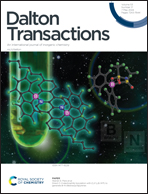Elucidating the catalytic mechanisms of O2 generation by [Mn2(μ-O)2(terpy)2(OH2)2]3+ using DFT calculations: a focus on ClO− as oxidant†
Abstract
The experimentally reported Mn(IV)Mn(III) complex [Mn2(μ-O)2(terpy)2(OH2)2]3+ has been observed catalyzing O2 generation with oxidants like ClO− and HSO5−. Previous mechanistic studies primarily focused on O2 generation with HSO5−, concluding that Mn(IV)Mn(III) acts as a catalyst, generating a Mn(IV)Mn(IV)–oxyl species as a key intermediate responsible for O–O bond formation. This computational study employs DFT calculations to investigate whether the catalytic generation of O2 using ClO− follows the same mechanism previously identified with HSO5− as the oxidant, or if it proceeds through an alternate pathway. To this end, we explored multiple pathways using ClO− as the oxidant. Interestingly, our findings confirm that in the case of ClO− as the oxidant, similar to what was observed with HSO5−, the Mn(IV)Mn(IV)–oxyl species indeed plays a crucial role in driving the catalytic evolution of O2 with the potential formation of the binuclear complexes Mn(IV)Mn(IV)–oxy and Mn(IV)Mn(IV)–OH during the reaction. These complexes are reactive in producing O2, with activation free energies of 15.9 and 14.3 kcal mol−1, respectively. However, our calculations revealed that the Mn(IV)Mn(IV)–oxyl complex is significantly more reactive in producing O2 than Mn(IV)Mn(IV)–oxy and Mn(IV)Mn(IV)–OH, with a lower free energy barrier of 8.1 kcal mol−1. Consequently, even though Mn(IV)Mn(IV)–oxyl is predicted to be present in much lower concentrations than Mn(IV)Mn(IV)–oxy and Mn(IV)Mn(IV)–OH, it emerges as the species acting as the active catalyst for catalytic O2 generation. This study enhances our knowledge of high oxidation state (+3 and +4) manganese chemistry, highlighting its key role in catalysis and paving the way for more efficient Mn-based catalysts with broad applications.
![Graphical abstract: Elucidating the catalytic mechanisms of O2 generation by [Mn2(μ-O)2(terpy)2(OH2)2]3+ using DFT calculations: a focus on ClO− as oxidant](/en/Image/Get?imageInfo.ImageType=GA&imageInfo.ImageIdentifier.ManuscriptID=D4DT00734D&imageInfo.ImageIdentifier.Year=2024)


 Please wait while we load your content...
Please wait while we load your content...